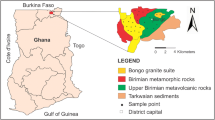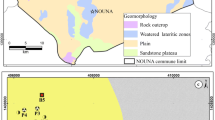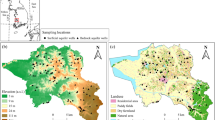Abstract
Two hundred and three groundwater samples were collected during March 2011 to June 2012 from the B2/A7 aquifer water supply wells of northern part of Jordan. The physicochemical properties were analyzed in situ for the major cations, anions, while certain heavy metals were analyzed in the laboratory. Some oilshale rock samples were geochemically analyzed. The Upper Cretaceous aquifer (B2/A7) is used as water supply for most of the communities in the study area. It consists of limestone, marly limestone, bedded chert, and minor phosphorite. Hydrochemical results from the B2/A7 aquifer indicate two main water types: alkaline-earth water (CaHCO3) and alkaline-earth water with high alkaline component (NaHCO3 –, Na2SO4). Standard column leaching experiments on oilshale rock samples and the R-mode factor analysis suggest that the sources for elevated Mo concentrations in the groundwater of certain parts of northern Jordan are attributed to water-oilshale interaction, mobility of Mo down to the groundwater and the extensive use of fertilizers within these areas. Molybdenum (Mo) concentrations in the groundwater water range from 0.07 to 1.44 mg/L with an average value of 98 μg/L. They are found to exceed the JISM and WHO guidelines in two areas in northern part of Jordan. Spatial distribution of Mo, using ordinary kriging techniques and the resulting map, shows high Mo concentration in the northwestern part near Wadi Al Arab area reaching concentrations of 650 μg/L and in the southeastern corner of the investigated area, south of Al Ukaydir village, with an average concentration of 468 μg/L. Both areas are characterized by extensive oilshale exposures with average concentration of 11.7 mg/kg Mo and intensive agricultural activities. These two areas represent approximately 33 % of the groundwater in the northern part of Jordan. Mobility of Mo to the groundwater in northern part of Jordan is attributed to two mechanisms. First, there is reductive dissolution of Fe-oxide, which releases substantial adsorbed Mo concentrations. Secondly, there is oxidation of Mo into dissolved forms in sulfide organic-rich system.













Similar content being viewed by others
References
Abed, A. (2000). Geology of Jordan (In Arabic) (1st ed.). Amman: Geological Association of Jordan.
Abed, A. M. (2013). The eastern Mediterranean phosphorite giants: an interplay between tectonics and upwelling. Geoarabia, 18(2), 67–94.
Abed, A. M., & Amireh, B. (1983). Petrography and geochemistry of some Jordanian oilshale from north Jordan. Journal of Petroleum Geology, 5, 261–274.
Abed, A. M., & Sadaqah, R. (2013). Enrichment of uranium in the uppermost Al-Hisa phosphorite formation, Eshidiyya basin, southern Jordan. Journal of African Earth Sciences, 77, 21–40.
Abed, A. M., Sadaqah, R., & Al Kuisi, M. (2008). Uranium and potentially toxic metals during the mining, beneficiation and processing of phosphorite and their effect on groundwater in Jordan. Mine Water Environment, 27, 171–182.
Abed, A., Arouri, K., Amireh, B., & Al-Hawari, Z. (2009). Characterization and genesis of some Jordanian oilshales. Dirasat, 36(1), 7–17.
Abed, A.M., Zghoul, Kh., Jaber, O., & Mohammad, W. (2015) Phosphogenesis of the Al-Kora phosphorites, NW Jordan with emphasis on uranium (in press).
Al Basha, A. (2012). Groundwater vulnerability to pollution with molybdenum in Yarmouk Basin, a semi-arid environment. Ms. Thesis, the University of Jordan, Amman, Jordan.
Al Hasan, T. (2008). Geochemistry of redox-sensitive trace elements and its implication on the mode of formation of the Upper Cretaceous oilshales, Central Jordan. Neues Jahrbuch für Geologie und Paläontologie (Abhandlungen), 249(3), 333–344.
Al Qudah, K., & Abu-Jaber, N. (2009). A GIS database for sustainable management of shallow water resources in the Tulul al Ashaqif region, NE Jordan. Water Resources Management, 23, 603–615.
Algeo, T. J., Schwark, L., & Hower, J. C. (2004). High-resolution geochemistry and sequence stratigraphy of the Hushpuckney Shale (Swope Formation, eastern Kansas): implications for climato-environmental dynamics of the Late Pennsylvanian mid-continent seaway. Chemical Geology, 206(3–4), 259–288.
Allison, J. D., Brown, D. S., & Novo-Gradac, K. J. (1991). MINTEQA2/PRODEFA2, a geochemical assessment model for environmental systems: version 3.0 User’s Manual. EPA/600/3-91/021. Washington: United States Environmental Protection Agency, Office of Research and Development.
Almogi‐Labin, A., Bein, A., & Sass, E. (1993). Late cretaceous upwelling system along the southern Tethys margin (Israel): interrelationship between productivity, bottom water environments, and organic matter preservation. Paleoceanography. doi:10.1029/93PA02197.
Alomary, A. (2012). Determination of trace metals in drinking water in Irbid City-Northern Jordan. Environmental Monitoring and Assessment, 185, 1969–1975.
Al-Taj, M. (2008). Structural control on groundwater distribution and flow in Irbid area, North Jordan. Journal of Earth and Environmental Sciences, 1(2), 81–88.
Amrhein, C., Mosher, P. A., & Brown, A. D. (1993). The effects of redox on Mo, U, B, V, and as solubility in evaporation pond soils. Soil Science, 155, 249–255.
Arnold, D., Greenberg, H., & Andrew, D. (1998). Standards methods for the examination of water and wastewater (20th ed.). Washington: American Public Health Association.
Atallah, M., & Mikbel, S. (1992). Structural analysis of the folds between Wadi El-Yabis and basalt plateau, Northern Jordan. Dirasat, 19(B), 43–58.
Awawdeh, M., & Jaradat, R. (2010). Evaluation of aquifers vulnerability to contamination in the Yarmouk River basin, Jordan, based on DRASTIC method. Arabian Journal Geosciences, 3(3), 273–282.
Barceloux, D. G. (1999). Molybdenum. Journal of Toxicology Clinical Toxicology, 37(2), 231–237.
Batayneh, A. (2010). Heavy metals in water springs of the Yarmouk Basin, North Jordan and their potentiality in health risk assessment. International Journal of the Physical Sciences, 5(7), 997–1003.
Bennett, B., & Dudas, M. J. (2003). Release of arsenic and molybdenum by reductive dissolution of iron oxides in a soil with enriched levels of native arsenic. Journal of Environmental Engineering and Science, 2, 265–272.
Berner, R. A., & Raiswell, R. (1983). Burial of organic carbon and pyrite sulphur in sediments over Phanerozoic time. Palaeogeography, Palaeoclimatology and Palaeoecology, 75, 97–122.
BGR & WAJ (1997). Mapping of groundwater vulnerability and hazards to groundwater in Irbid area, northern Jordan. The Federal Institute for Geosciences and Natural Resources (BGR) and Water Authority of Jordan (WAJ), Technical cooperation project “Groundwater resources of northern Jordan”, Special report No. 3, Hannover and Amman.
Bopeng, S., Xiao, M., & Song, Z. (2006). Geochemistry of soils derived from black shale, Central Hunan. Chinese Journal of Geochemistry, 25(1), 85–86.
Bostick, B. C., Fendorf, S., & Helz, G. R. (2003). Differential adsorption of molybdate and tetrathiomolybdate on pyrite (FeS2). Environmental Science and Technology, 37, 285–291.
Boyle, D.R. (2003). Preglacial weathering of massive sulfide deposits in the Bathurst Mining Camp: economic geology, geochemistry, and exploration applications. In: W. D Goodfellow, S. R. McCutcheon, J. M. Peter (Eds.), Massive Sulphide Deposits of the Bathurst Mining Camp (pp. 689–721). New Brunswick.
Bruland, K.W., & Lohan, M.C. (2003). Controls of trace metals in seawater. In: Elderfield, H. (Ed.), The Oceans and Marine Geochemistry. In: H. D Holland, K. K Turekian (Exec. Eds.), Treatise on Geochemistry 6 (pp. 23–47) Elsevier-Pergamon: Oxford
Chadha, D. K. (1999). A proposed new diagram for geochemical classification of natural waters and interpretation of chemical data. Hydrogeology Journal, 7, 431–439.
Das, A. K., Chakraborty, R., Cervera, M. L., & de la Guardia, M. (2007). A review on molybdenum determination in solid geological samples. Talanta, 71(3), 987–1000.
Dzombak, D. A., & Morel, F. M. (1990). Surface complexation modeling: hydrous ferric oxide. New York: Wiley-Interscience.
Eisler, R. (2000). Handbook of chemical risk assessments: health hazards to humans, plants, and animals. Boca Raton: CRC.
El Hiyari, M. (1985). The geology of Jabal Al-Muttarammil. Jordan: Bull. 1, Geol. Mapping Div., Geol. Dir., Natural Resources Authority.
Erickson, B., & Helz, G. (2000). Molybdenum (VI) speciation in sulfidic waters: stability and lability of thiomolybdates. Geochimica et Cosmochimica Acta , 64, 1149–1158.
Fouad, H. K., & El-Rakaiby, R. M. (2009). Environmental geochemistry for heavy metals and uranium potentiality in oilshale sediments, Quseir, Red Sea, Egypt. Journal of Applied Sciences Research, 5(8), 914–921.
Gibbs, R. (1970). Mechanism controlling world river water chemistry. Science, 170, 1088–1090.
Gibbs, R. (1971). Mechanism controlling world river water chemistry: evaporation-crystallization process. Science, 172, 871–872.
Goldberg, S., Forster, H. S., & Godfrey, C. L. (1996). Molybdenum adsorption on oxides, clay minerals, and soils. Soil Science Society of America Journal, 60, 425–432.
Helz, G. R., Miller, C. V., Charnock, J. M., Mosselmans, J. F. W., Pattrick, R. A. D., Garner, C. D., & Vaughan, D. J. (1996). Mechanism of molybdenum removal from the sea and its concentration in black shales: EXAFS evidence. Geochimica et Cosmochimica Acta , 60, 3631–3642.
Helz, G. R., Vorlicek, T. P., & Kahn, M. D. (2004). Molybdenum scavenging by iron monosulfide. Environmental Science and Technology, 38, 4263–4268.
Helz, G. R., Bura-Nakić, E., Mikac, N., & Ciglenečki, I. (2011). New model for molybdenum behavior in euxinic waters. Chemical Geology, 284, 323–332.
Hunting Technical Services, Soil Survey and Land Research Centre (HTS and SSLRC) (1993). The Soils of Jordan. Ministry of Agriculture, National Soil Map and Land Use Project, Level 1: Reconnaissance Soil Survey (Scale 1:250,000), 3 Volumes, Amman.
Jordanian Institute of Standards and Metrology (JISM) (2008). Drinking water standards. Amman, No. 286/2008.
Kaback, D. S., & Runnells, D. R. (1980). Geochemistry of molybdenum in some stream sediments and waters. Geochimicaet Cosmochimica Acta, 44, 447–456.
Margana, A. (2006). Hydrogeological proposal for the delineation of a groundwater protection area for the Wadi Al Arab well field. Amman: Technical Cooperation ProjectMWI – BGR, Ministry of Water and Irrigation.
Masri, M. (1963). Report on the geology of Amman-ZarqaArea. Amman: Report for Central Water Authority.
Mazor, E., Levitte, D., Truesdell, A. H., Healy, J., & Nissenbaum, A. (1980). Mixingmodels and ionic geothermometers applied to warm water (up to 60 °C) springs: Jordan Rift Valley, Israel. Journal of Hydrology, 45, 1–19.
McEwan, A. G., Ridge, J. P., & McDevitt, C. A. (2001). The DMSO reductase family of microbial molybdenum enzymes; molecular properties and role in the dissimilatory reduction of toxic elements. Geomicrobiology Journal, 19, 3–21.
Morrison, S. J., & Spangler, R. R. (1992). Extraction of uranium and molybdenum from aqueous-solutions—a survey of industrial materials for use in chemical barriers for uranium mill tailings remediation. Environmental Science & Technology, 26, 1922–1931.
Mulwa, J., Gaciri, S., Barongo, J., Opiyo-Akech, N., & Kianji, K. (2005). Geological and structural influence on groundwater distribution and flow in Ngong area, Kenya. African Journal of Science and Technology, 6(1), 105–115.
Piper A. M. (1944) A graphic procedure in geochemical interpretation of water analysis. Transactions of the American Geophysical Union, 25(6), 914–928.
Powell, J. H. (1989). Stratigraphy and sedimentation of the Phanerozoic rocks in central and southern Jordan. Amman: Bulletin 11, Natural Resources Authority.
Salameh, E., Alraggad, M., & Trawneh, A. (2014). Natural salinity sources in the groundwaters of Jordan—importance of sustainable aquifer management. ChemieErde - Geochemistry. doi:10.1016/j.chemer.2014.04.007.
Schlieker, M., Schüring, J., Hencke, J., & Schulz, H. D. (2001). The influence of redox processes on trace element mobility in a sandy aquifer—an experimental approach. Journal of Geochemical Exploration, 73, 167–179.
Siebert, C., Möller, P., Geyer, S., Kraushaar, S., Dulski, P., Guttman, J., Subah, A., & Rödiger, T. (2014). Thermal waters in the Lower Yarmouk Gorge and their relation to surrounding aquifers. Chemie der Erde, 74, 425–441.
Smedley, P. L., Cooper, D. M., Ander, E. L., Milne, C. J., & Lapworth, D. J. (2014). Occurrence of molybdenum in British surface water and groundwater: distributions, controls and implications for water supply. Applied Geochemistry, 40(2014), 144–154.
Vorlicek, T. P., Kahn, M. D., Kasuya, Y., & Helz, G. R. (2004). Capture of molybdenum in pyrite-forming sediments: role of ligand-induced reduction by polysulfides. Geochimica et Cosmochimica Acta, 68, 547–556.
Vyskočil, A., & Viau, C. (1999). Assessment of molybdenum toxicity in humans. Journal of Applied Toxicology, 19, 185–192.
Wang, D. L., Aller, R. C., & Sanudo-Wilhelmy, S. A. (2011). Redox speciation and early diagenetic behavior of dissolved molybdenum in sulfidic muds. Marine Chemistry, 125, 101–107.
Wichard, T., Mishra, B., Myneni, S. C. B., Bellenger, J. P., & Kraepiel, A. M. L. (2009). Storage and bioavailability of molybdenum in soils increased by organic matter complexation. Nature Geoscience, 2, 625–629.
World Health Organization (WHO) (2011). Guidelines for drinking water quality (4th ed.). Geneva.http://www.who.int/water_sanitation_health/publications/2011/dwq_guidelines/en/
Xu, N., Christodoulatos, C., & Braida, W. (2006a). Adsorption of molybdate and tetrathiomolybdate onto pyrite and goethite: effect of pH and competitive anions. Chemosphere, 62, 1726–1735.
Xu, N., Christodoulatos, C., & Braida, W. (2006b). Modeling the competitive effect of phosphate, sulfate, silicate, and tungstate anions on the adsorption of molybdate onto goethite. Chemosphere, 64, 1325–1333.
Acknowledgments
Thanks are due to the anonymous reviewers of this journal for highly improving the manuscript. Special thanks for Gentry Catlett from Miami University for reading and improving the text of the manuscript. Thanks and gratitude are due to the Deanship of Scientific Research at the University of Jordan for supporting and sponsoring this research. This research has been accomplished during the sabbatical leave in Miami University sponsored by the University of Jordan starting from the spring semester 2013–2014.
Author information
Authors and Affiliations
Corresponding author
Rights and permissions
About this article
Cite this article
Al Kuisi, M., Al-Hwaiti, M., Mashal, K. et al. Spatial distribution patterns of molybdenum (Mo) concentrations in potable groundwater in Northern Jordan. Environ Monit Assess 187, 148 (2015). https://doi.org/10.1007/s10661-015-4264-5
Received:
Accepted:
Published:
DOI: https://doi.org/10.1007/s10661-015-4264-5




